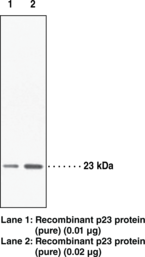| References |
| Synonyms |
- cPGES
- cPGE Synthase
- p23
- Hsp90 Co-chaperone
|
| Formulation |
Peptide affinity-purified IgG |
| Stability |
1 year |
| Storage |
-20°C |
| Shipping |
Wet ice
in continental US; may vary elsewhere
|
| Specificity |
| Human cPGES |
+ |
| Mouse cPGES |
+ |
| Microsomal PGES-1 |
+ |
| Microsomal PGES-2 |
+ |
Show all 4
Hide all but first 3
|
Background Reading
Tanioka, T., Nakatani, Y., Semmyo, N., et al. Molecular identification of cytosolic prostaglandin E2 synthase that is functionally coupled with cyclooxygenase-1 immediate prostaglandin E2 biosynthesis. J Biol Chem 275 32775-32782 (2000).
Jakobsson, P., Thorén, S., Morgenstern, R., et al. Identification of human prostaglandin E synthase: A microsomal, glutathione-dependent, inducible enzyme, constituting a potential novel drug target. Proc Natl Acad Sci USA 96 7220-7225 (1999).
| Size |
Global Purchasing |
| 500 µl |
|
Description
Antigen:
full length, human recombinant cPGES
·
Host:
rabbit
·
Application(s):
WB and ICC
·
Cytosolic PGE synthase (cPGES) is a glutathione-dependent enzyme with a predicted size of 18.6 kDa (23 kDa on SDS-PAGE). The enzyme is expressed in a wide variety of tissues and cells, the levels of which are unaffected by treatment with IL-1β and TNFα.1 However, enzyme expression increases approximately 3-fold in rat brain following LPS treatment.1 Microsomal PGE synthase (mPGES) is a 16 kDa protein expressed in a variety of tissues.2 In contrast to cPGES, mPGES protein expression is increases in A549 cells following treatment with IL-1β.2 The two enzymes show <10% homology at the amino acid level.
1
Tanioka, T., Nakatani, Y., Semmyo, N., et al. Molecular identification of cytosolic prostaglandin E2 synthase that is functionally coupled with cyclooxygenase-1 immediate prostaglandin E2 biosynthesis. J Biol Chem 275 32775-32782 (2000).
2
Jakobsson, P., Thorén, S., Morgenstern, R., et al. Identification of human prostaglandin E synthase: A microsomal, glutathione-dependent, inducible enzyme, constituting a potential novel drug target. Proc Natl Acad Sci USA 96 7220-7225 (1999).
|






